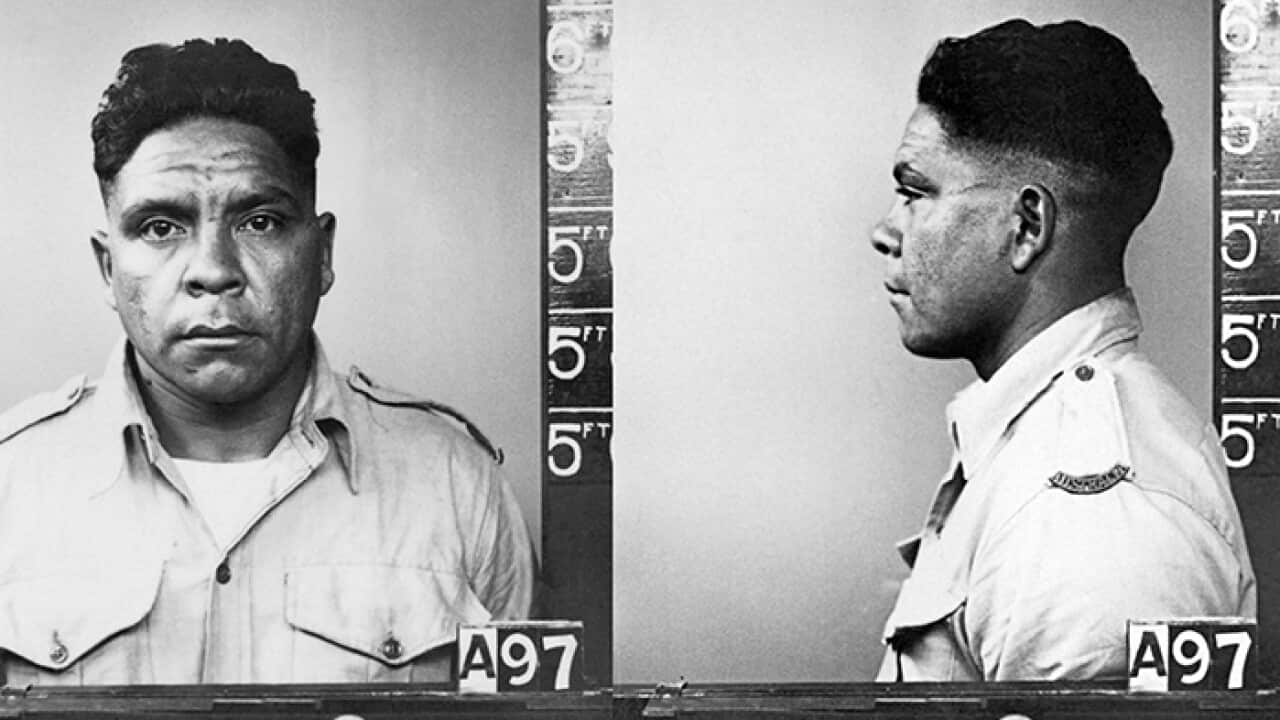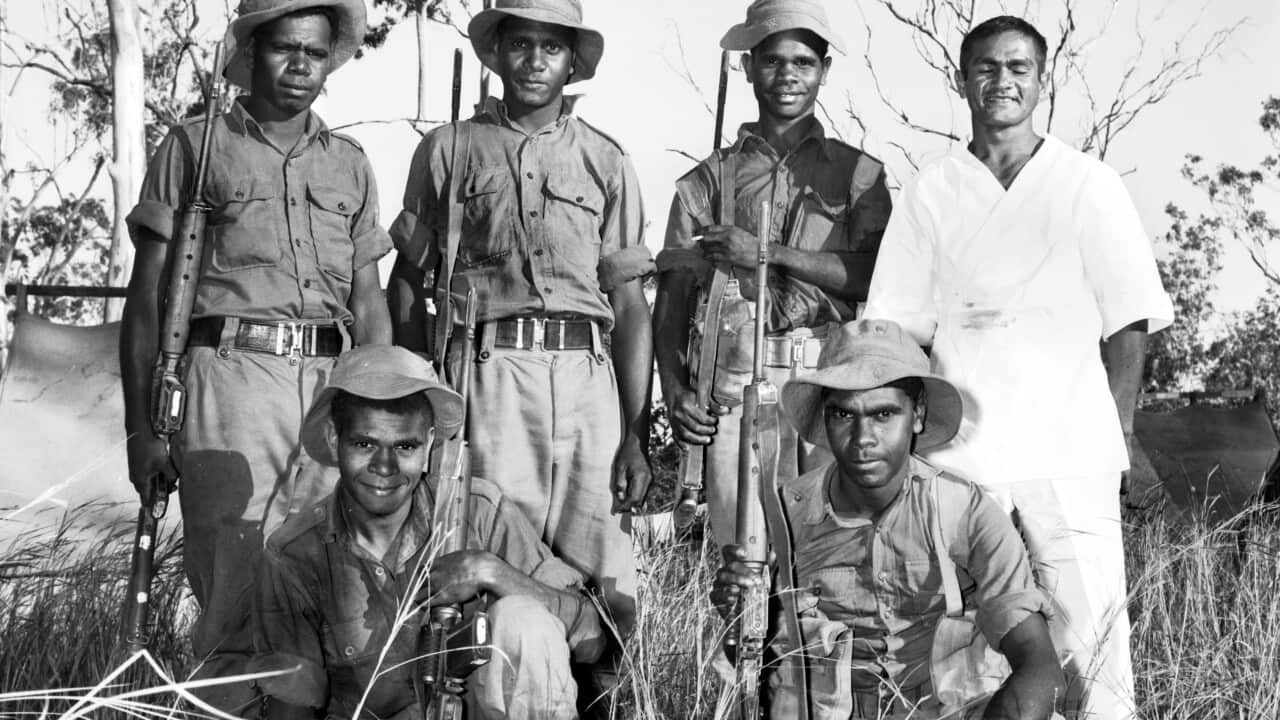Danggalaba Kulumbirigin man Tibby Quall remembers his great aunt, Larrakia woman Dolly Gurinyi Batcho, who served in the Australian Women’s Army Service Barracks during WWII.
“Yeah she had a strong character,” Tibby smiles. “She was a ceremonial leader for our women's ceremony, she was in charge of women's ceremony, the boss of the ceremonies held here in Darwin and around the country and cox peninsula.
“She was a ceremonial leader for our women's ceremony, she was in charge of women's ceremony, the boss of the ceremonies held here in Darwin and around the country and cox peninsula.

Tibby Quall says his great aunt, Larrakia woman Dolly Gurinyi Batcho, went from fighting for this country to fighting for rights in this country. Source: NITV, Elliana Lawford
“She was a leader, she always used to growl us for doing anything wrong,” he laughs.
After serving in WWII a new fight began for Dolly, the fight for social justice and land rights.
“She was very strong in the land claims, she gave a lot of principal evidence for the claims,” says Tibby.
“And we won two land claims in Darwin, Kulalak and Larrakia Barracks in 1975 through the Land Commissioner.
“So they set the foundations for us, Uncle Victor and Nanna Dolly.”
Dolly is featured in the digital exhibition, Facing Two Fronts: The Fight for Respect, by the National Archives of Australia. Facing Two Fronts is the first exhibition of its kind – exploring the link between Aboriginal and Torres Strait Islander military service and the fight for social justice.
Facing Two Fronts is the first exhibition of its kind – exploring the link between Aboriginal and Torres Strait Islander military service and the fight for social justice.

Tibby Quall with the Facing Two Fronts Exhibition Curator, Amy Lay. Source: NITV, Elliana Lawford
“In some cases this service gave people the opportunity to mix with the sorts of people they wouldn't otherwise have, gave them the confidence to advocate on their own behalf; in other cases it gave people a taste of freedom or equal treatment so we can't extricate the two, we have to recognise there is a relationship there,” the exhibition’s curator, Amy Lay, explains.
“And in some cases the advocacy and activism is expressed in a desire not to serve, or that the loss of a loved one in war inspires a person to fight for rights.”
The videos and pictures don't just document the front line soldiers of the Second World War, they go much further into the past.
“There are stories that go back to WW1, stories of enlistment and rejection of enlistment, we also have stories from WWII including those who actually served and un-enlisted service people,” says Lay.
“Many of them weren’t paid at the time or if they were paid they were only paid in rations, and many were not even formally recognised until relatively recently.” Kungarakany man Joe McGinness is another face that can be found in the exhibition's window into the past.
Kungarakany man Joe McGinness is another face that can be found in the exhibition's window into the past.

Kungarakany man Joe McGinness served in Borneo during the Second World War in 1942. Source: National Archives of Australia
Like Dolly, he fought in WWII and returned home to fight a battle against inequality.
“Dad's activism started earlier on in his life, there were many injustices that dad suffered both personally and witnessed,” his daughter Sandra reveals.
“I was surprised that dad didn't end up a very bitter man, he always said 'oh there's going to be a change'.”
Joe grew up in Kahlin Aboriginal Compound, an establishment set up in Darwin in 1913 as a reserve in which to segregate and control Aboriginal people.
He later served in Borneo during the Second World War, and went on to become president of the Federal Council for the Advancement of Aborigines and Torres Strait Islanders, campaigning for Indigenous rights in the period leading up to the 1967 referendum.
“We lived in Sydney for a year, we re-located so he could focus on the referendum, there was a lot of work involved, they had to coordinate all the states and territories,” Sandra says.
“Dad was a wonderful person, he was a staunch ally, he was a worldly man, he was interested in world politics, and even though he was quietly spoken he had a certain charisma to him.” It’s hoped the exhibition will create awareness about the enduring discrimination First Nations soldiers faced back on home soil after serving.
It’s hoped the exhibition will create awareness about the enduring discrimination First Nations soldiers faced back on home soil after serving.

Facing Two Fronts; The Fight for Respect is a digital representation of Indigenous soldiers and their fight for justice as told by their family members. Source: NITV, Elliana Lawford
“I really like the exhibition because it shows what Aboriginal people have been through - their life, the Aboriginal Protection and Land Rights and Intervention and social justice, and education, and health - it all leads into one bowl or bucket, there's that many issues we've had to fight for,” Tibby says.
“The more it's out there in the public people can see our struggle and how it started, it's a way of equality.”
The exhibition is on display at the National Archives of Australia in Darwin until January 2018.












